Numerical Investigation of the Influence of Precooling on the Thermal Performance of a Borehole Heat Exchanger
Abstract
:1. Introduction
2. Model and Validation
3. Results and Analyses
3.1. The Influence of Precooling Time on the Dynamic Soil Temperature
3.2. The Influence of Precooling Time on Thermal Radius
3.3. The Influence of Soil Type on Thermal Radius
3.4. Numerical Formula for the Thermal Radius
4. Conclusions
Author Contributions
Funding
Institutional Review Board Statement
Informed Consent Statement
Data Availability Statement
Conflicts of Interest
References
- Xu, L.; Pu, L.; Zhang, S.; Li, Y. Hybrid ground source heat pump system for overcoming soil thermal imbalance: A review. Sustain. Energy Technol. Assess. 2021, 44, 101098. [Google Scholar] [CrossRef]
- Zhang, J.; Zhang, H.-H.; He, Y.-L.; Tao, W.-Q. A comprehensive review on advances and applications of industrial heat pumps based on the practices in China. Appl. Energy 2016, 178, 800–825. [Google Scholar] [CrossRef]
- Xi, J.; Li, Y.; Liu, M.; Wang, R.Z. Study on the thermal effect of the ground heat exchanger of GSHP in the eastern China area. Energy 2017, 141, 56–65. [Google Scholar] [CrossRef]
- Abbas, Z.; Chen, D.; Li, Y.; Yong, L.; Wang, R.Z. Experimental investigation of underground seasonal cold energy storage using borehole heat exchangers based on laboratory scale sandbox. Geothermics 2020, 87, 101837. [Google Scholar] [CrossRef]
- Fan, R.; Jiang, Y.; Yao, Y.; Ma, Z. Theoretical study on the performance of an integrated ground-source heat pump system in a whole year. Energy 2008, 33, 1671–1679. [Google Scholar] [CrossRef]
- Fan, R.; Jiang, Y.; Yao, Y.; Shiming, D.; Ma, Z. A study on the performance of a geothermal heat exchanger under coupled heat conduction and groundwater advection. Energy 2007, 32, 2199–2209. [Google Scholar] [CrossRef]
- Yang, T.; Zhang, X.; Zhou, B.; Zheng, M. Simulation and experimental validation of soil cool storage with seasonal natural energy. Energy Build. 2013, 63, 98–107. [Google Scholar] [CrossRef]
- Yu, Y.; Ma, Z.; Li, X. A new integrated system with cooling storage in soil and ground-coupled heat pump. Appl. Therm. Eng. 2008, 28, 1450–1462. [Google Scholar] [CrossRef]
- Sagia, Z.; Rakopoulos, C.; Kakaras, E. Cooling dominated hybrid ground source heat pump system application. Appl. Energy 2012, 94, 41–47. [Google Scholar] [CrossRef]
- Pertzborn, A.J.A.T. Thermal storage properties of a hybrid ground source heat pump. ASHRAE Trans. 2012, 118, 34. [Google Scholar]
- Pertzborn, A.J. An Examination of Control Strategies in a HyGSHP System. In International High Performance Buildings Conference; Purdue University: West Lafayette, IN, USA, 2012; Available online: http://docs.lib.purdue.edu/ihpbc/61 (accessed on 10 November 2021).
- Pertzborn, A.J.; Nellis, G.F.; Klein, S.A. An evaluation of the effectiveness of pre-cooling in hybrid ground source heat pump systems. Proc. SimBuild 2012, 5, 144–151. [Google Scholar]
- Johansson, E. Optimization of Ground Source Cooling Combined with Free Cooling for Protected Sites. Master’s Thesis, Department of Applied Thermodynamics and Refrigeratio, KTH School of Industrial Engineering and Management, Stockholm, Sweden, 2012. [Google Scholar]
- Hackel, S.; Pertzborn, A. Effective design and operation of hybrid ground-source heat pumps: Three case studies. Energy Build. 2011, 43, 3497–3504. [Google Scholar] [CrossRef]
- Zhou, S.; Cui, W.; Li, Z.; Liu, X. Feasibility study on two schemes for alleviating the underground heat accumulation of the ground source heat pump. Sustain. Cities Soc. 2016, 24, 1–9. [Google Scholar] [CrossRef]
- Alaica, A.A.; Dworkin, S.B. Characterizing the effect of an off-peak ground pre-cool control strategy on hybrid ground source heat pump systems. Energy Build. 2017, 137, 46–59. [Google Scholar] [CrossRef]
- Yi, M.; Hongxing, Y.; Zhaohong, F. Study on hybrid ground-coupled heat pump systems. Energy Build. 2008, 40, 2028–2036. [Google Scholar] [CrossRef]
- Fan, R.; Gao, Y.; Hua, L.; Deng, X.; Shi, J. Thermal performance and operation strategy optimization for a practical hybrid ground-source heat-pump system. Energy Build. 2014, 78, 238–247. [Google Scholar] [CrossRef]
- Yang, W.; Zhang, H.; Liang, X. Experimental performance evaluation and parametric study of a solar-ground source heat pump system operated in heating modes. Energy 2018, 149, 173–189. [Google Scholar] [CrossRef]
- Zhou, Y.; Zhao, L.; Wang, S. Determination and analysis of parameters for an in-situ thermal response test. Energy Build. 2017, 149, 151–159. [Google Scholar] [CrossRef]
- Zhang, C.; Chen, P.; Liu, Y.; Sun, S.; Peng, D. An improved evaluation method for thermal performance of borehole heat exchanger. Renew. Energy 2014, 77, 142–151. [Google Scholar] [CrossRef]
- Hart, D.P.; Couvillion, R. Earth Coupled Heat Transfer; Publication of National Water Well Association: Dublin, Ireland, 1986. [Google Scholar]
- Kelvin, S.; Thomson, W. Mathematical and Physical Papers, 2nd ed.; Cambridge University Press: Cambridge, UK, 1882; Volume 2, p. 41. [Google Scholar]
- Zhou, S.; Cui, W.; Tao, J.; Peng, Q. Study on ground temperature response of multilayer stratums under operation of ground-source heat pump. Appl. Therm. Eng. 2016, 101, 173–182. [Google Scholar] [CrossRef]
- Li, W.; Li, X.; Peng, Y.; Wang, Y.; Tu, J. Experimental and numerical investigations on heat transfer in stratified subsurface materials. Appl. Therm. Eng. 2018, 135, 228–237. [Google Scholar] [CrossRef]
- Zhong, K.; Wang, Y.; Pei, J.; Tang, S.; Han, Z. Super efficiency SBM-DEA and neural network for performance evaluation. Inf. Process. Manag. 2021, 58, 102728. [Google Scholar] [CrossRef]
- Zhong, K.; Li, C.; Wang, Q. Evaluation of bank innovation efficiency with data envelopment analysis: From the perspective of uncovering the black box between input and output. Mathematics 2021, 9, 3318. [Google Scholar] [CrossRef]
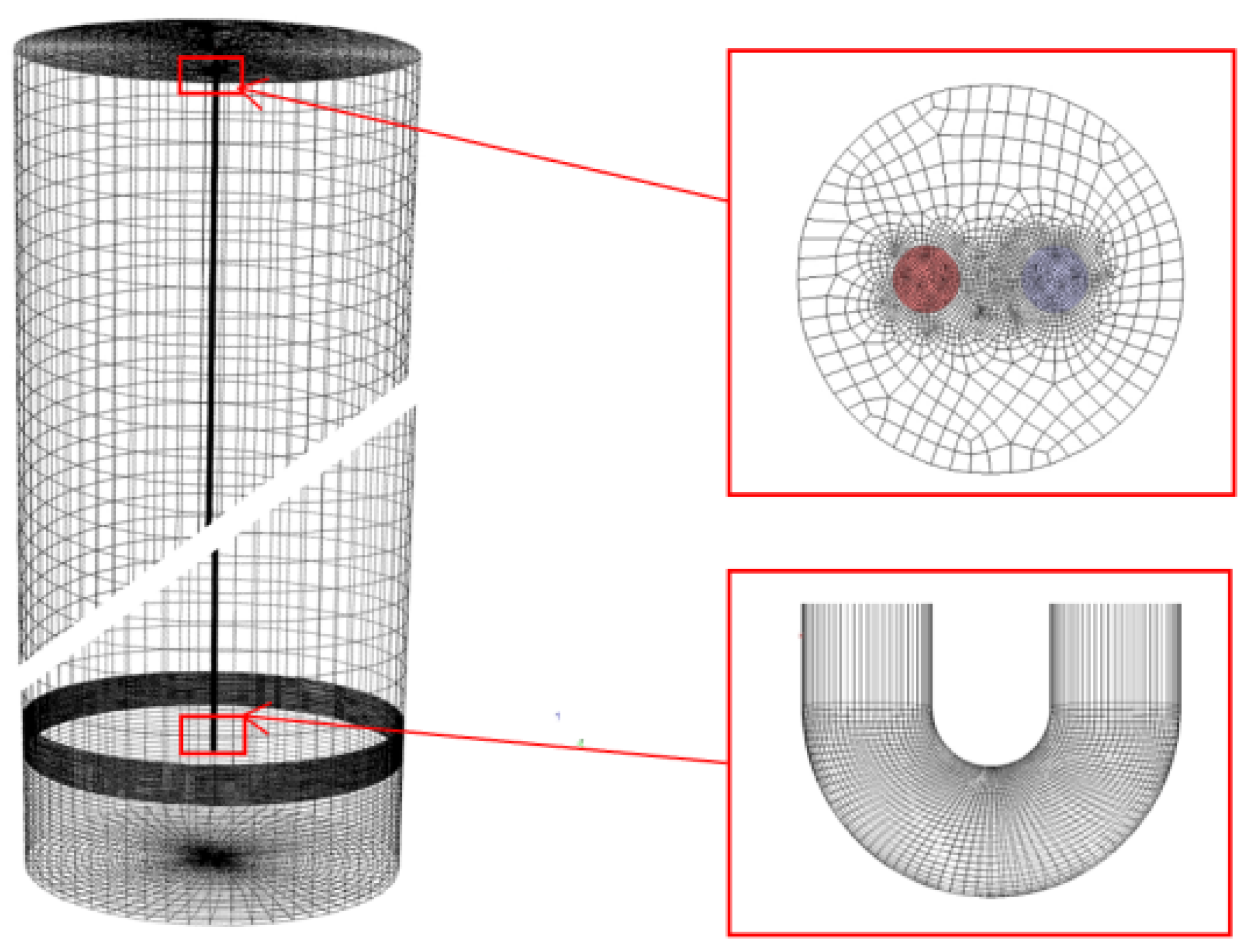
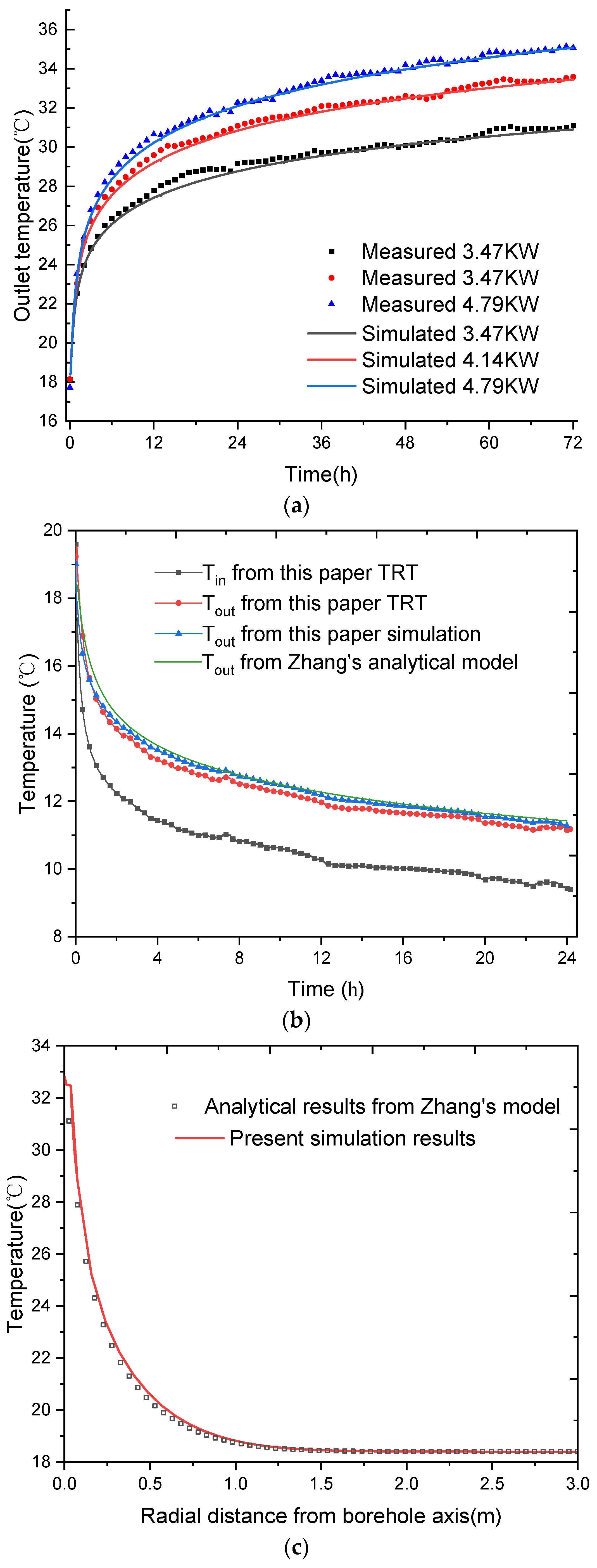
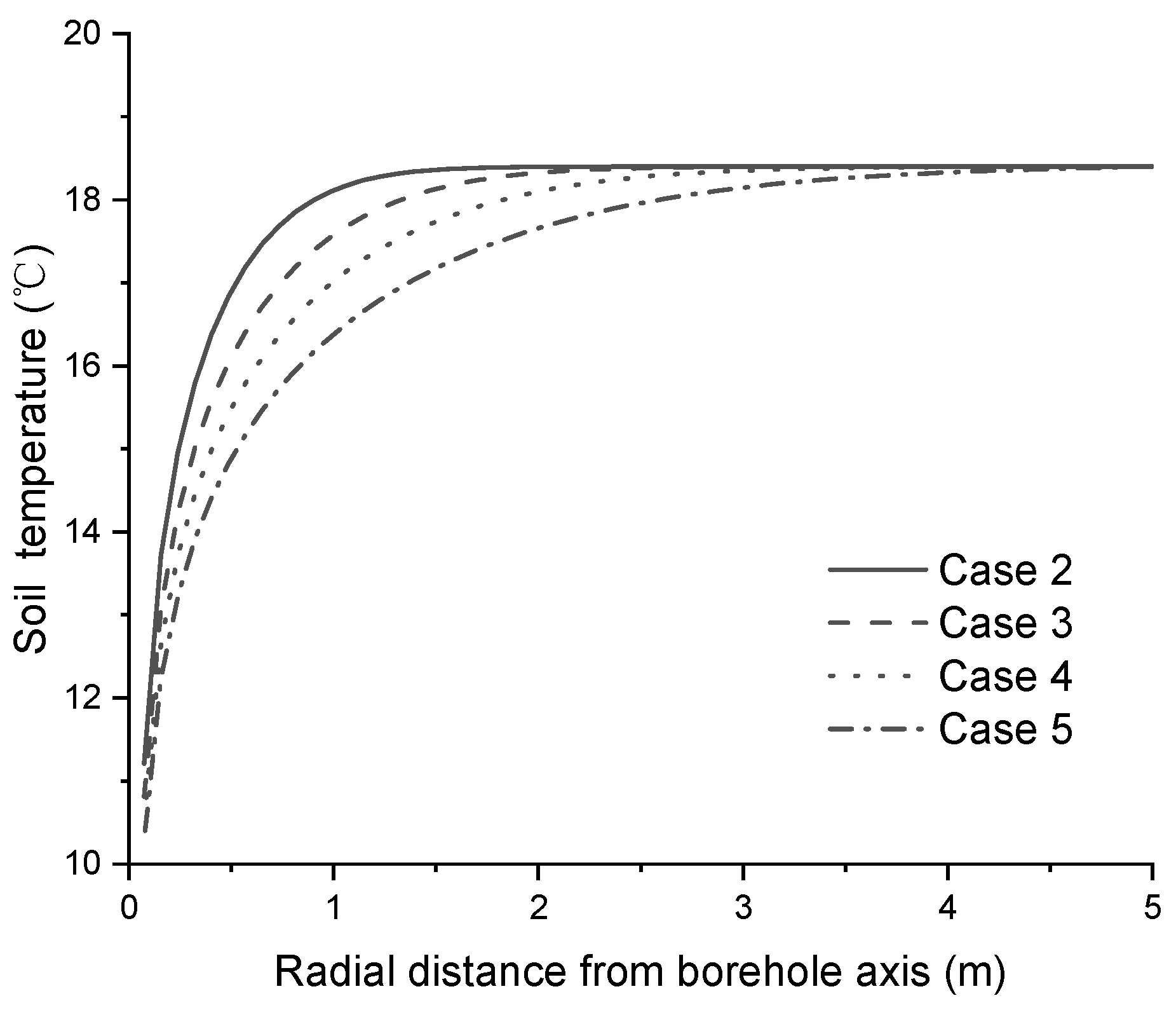
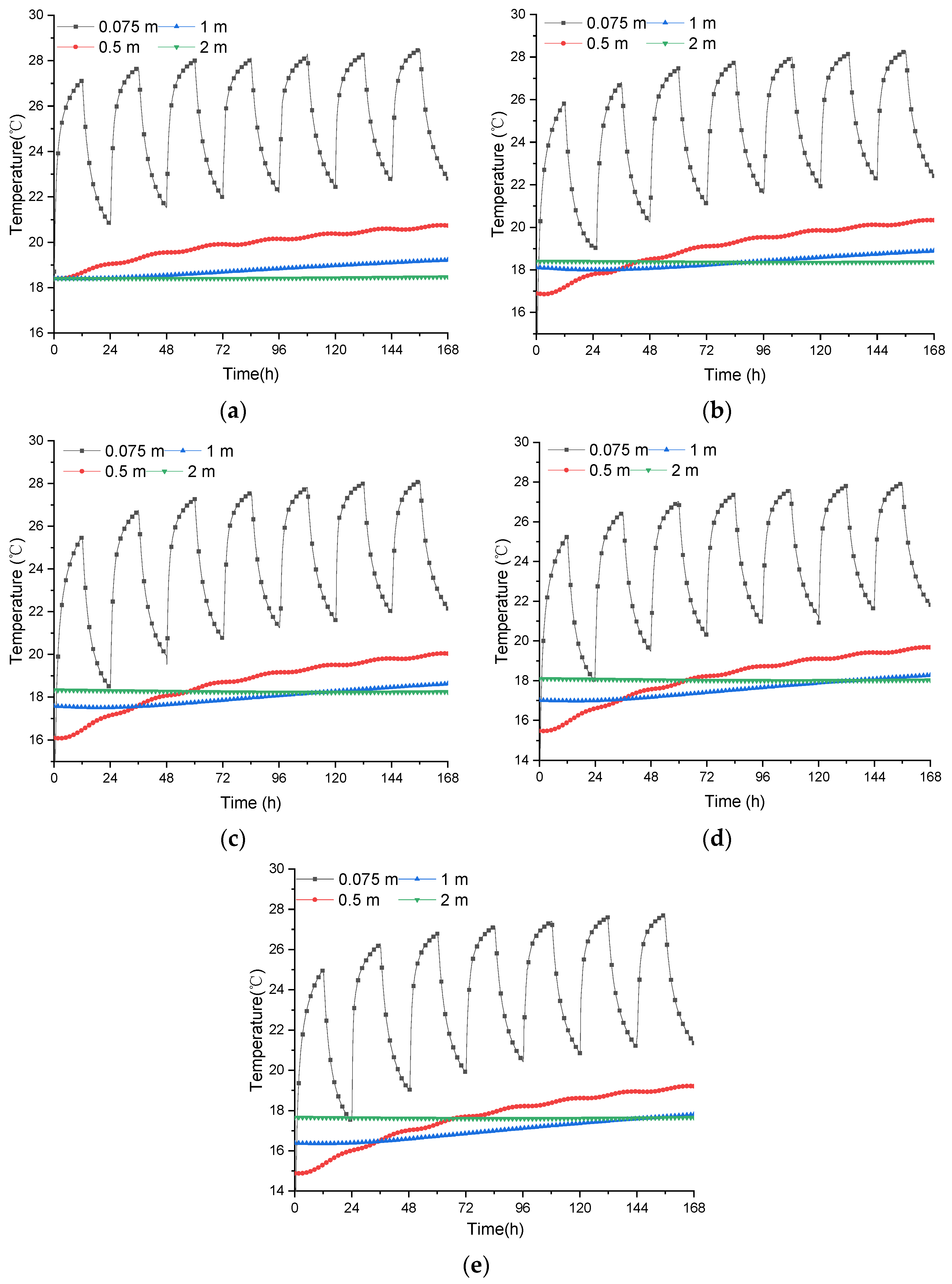

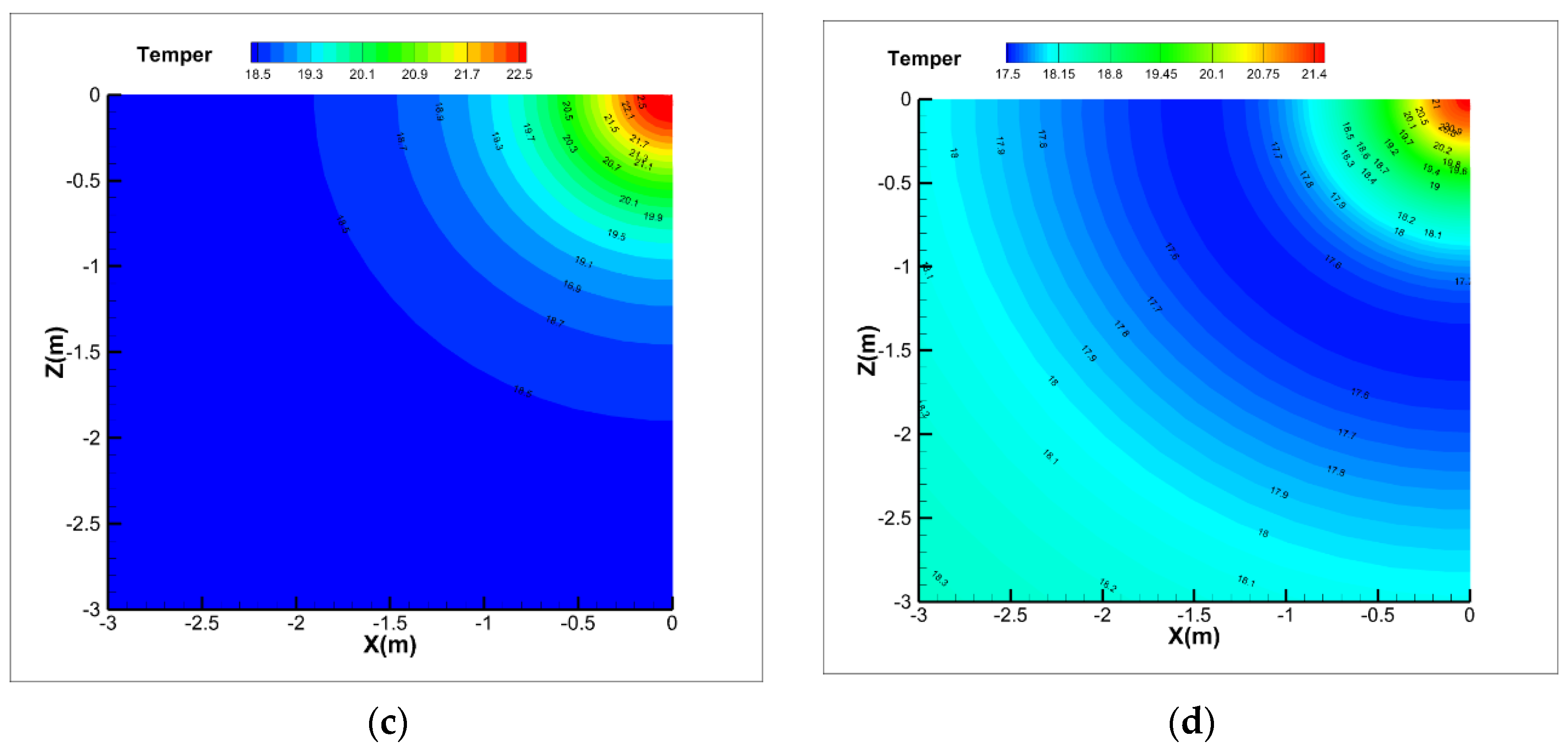
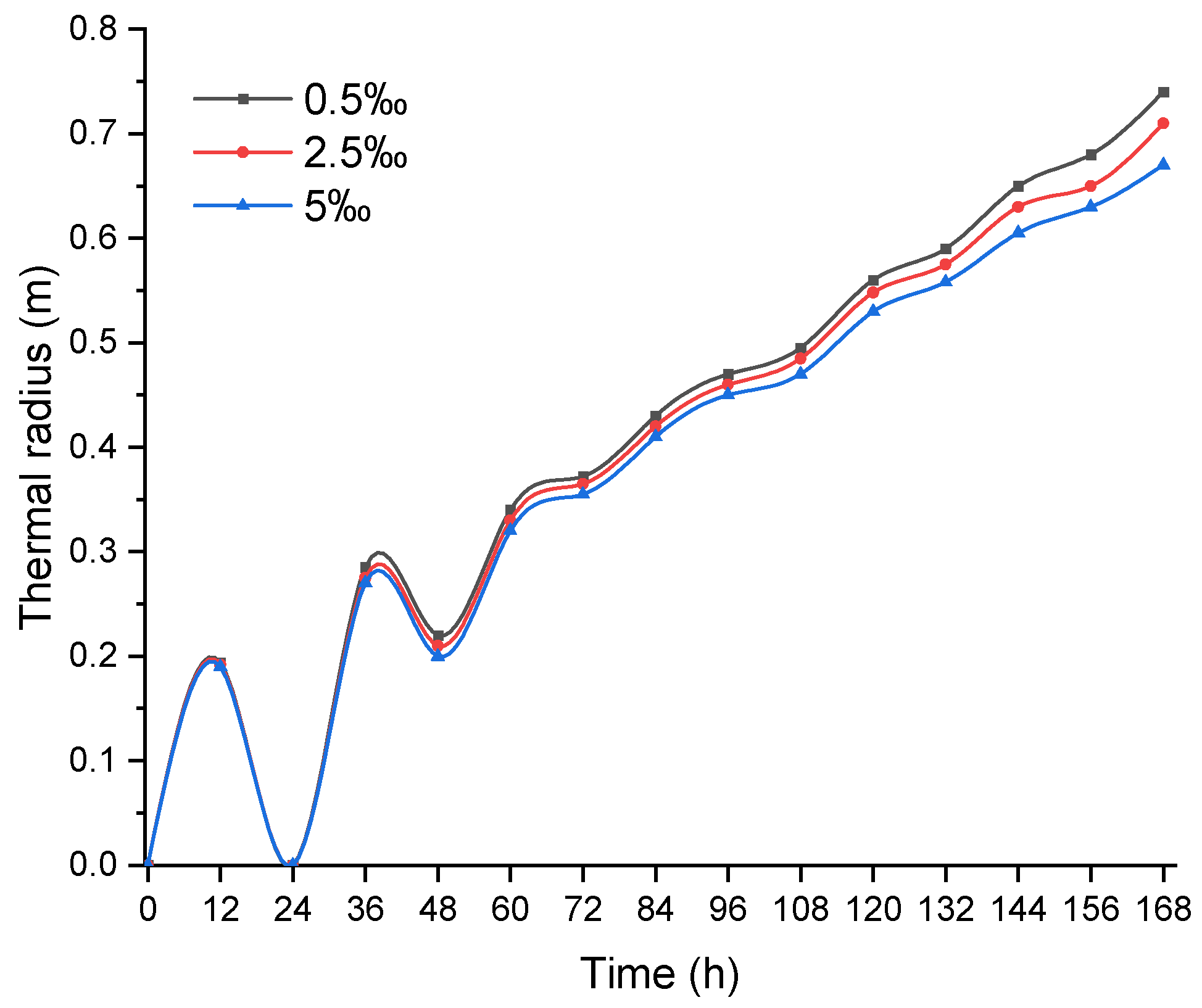

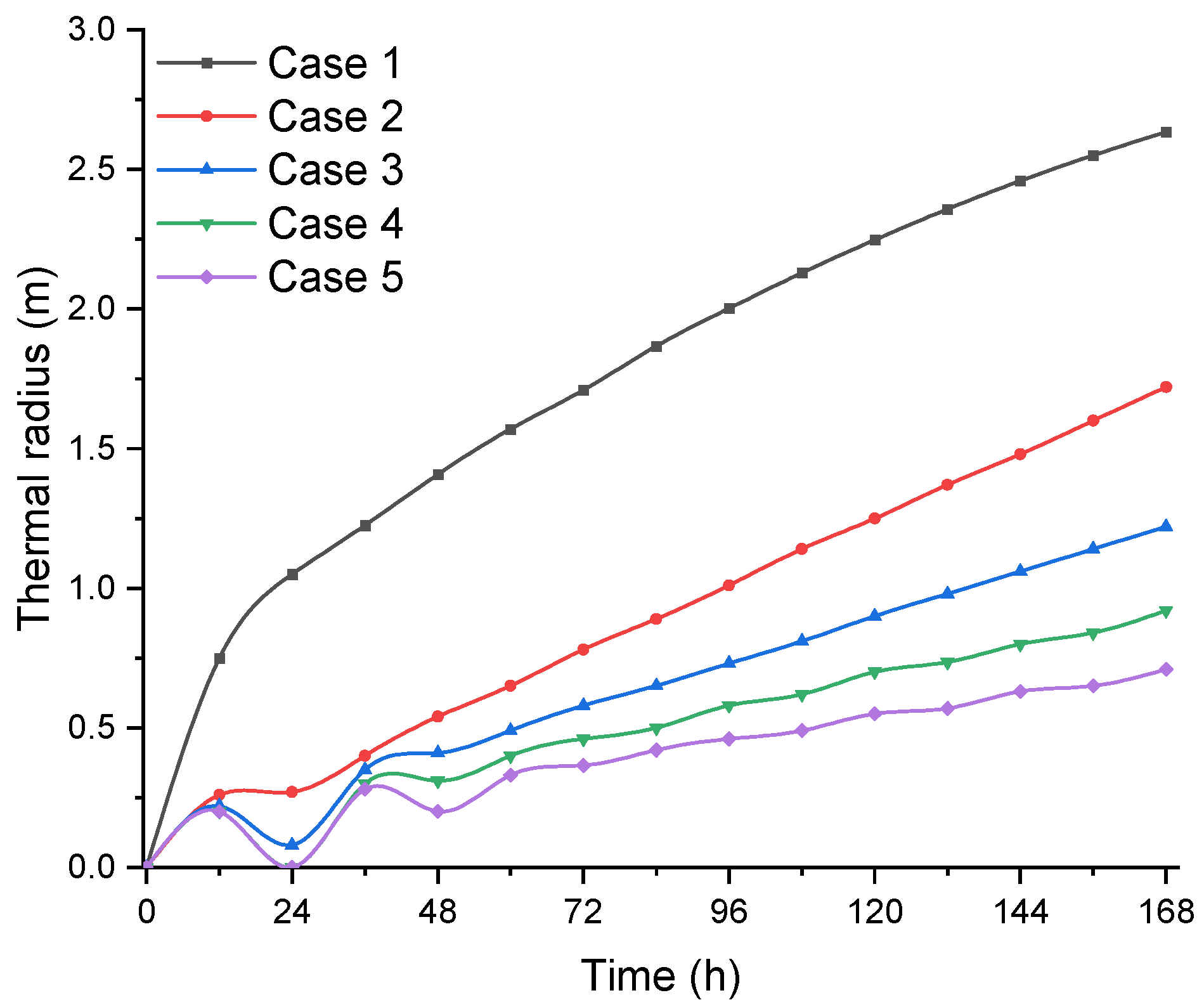

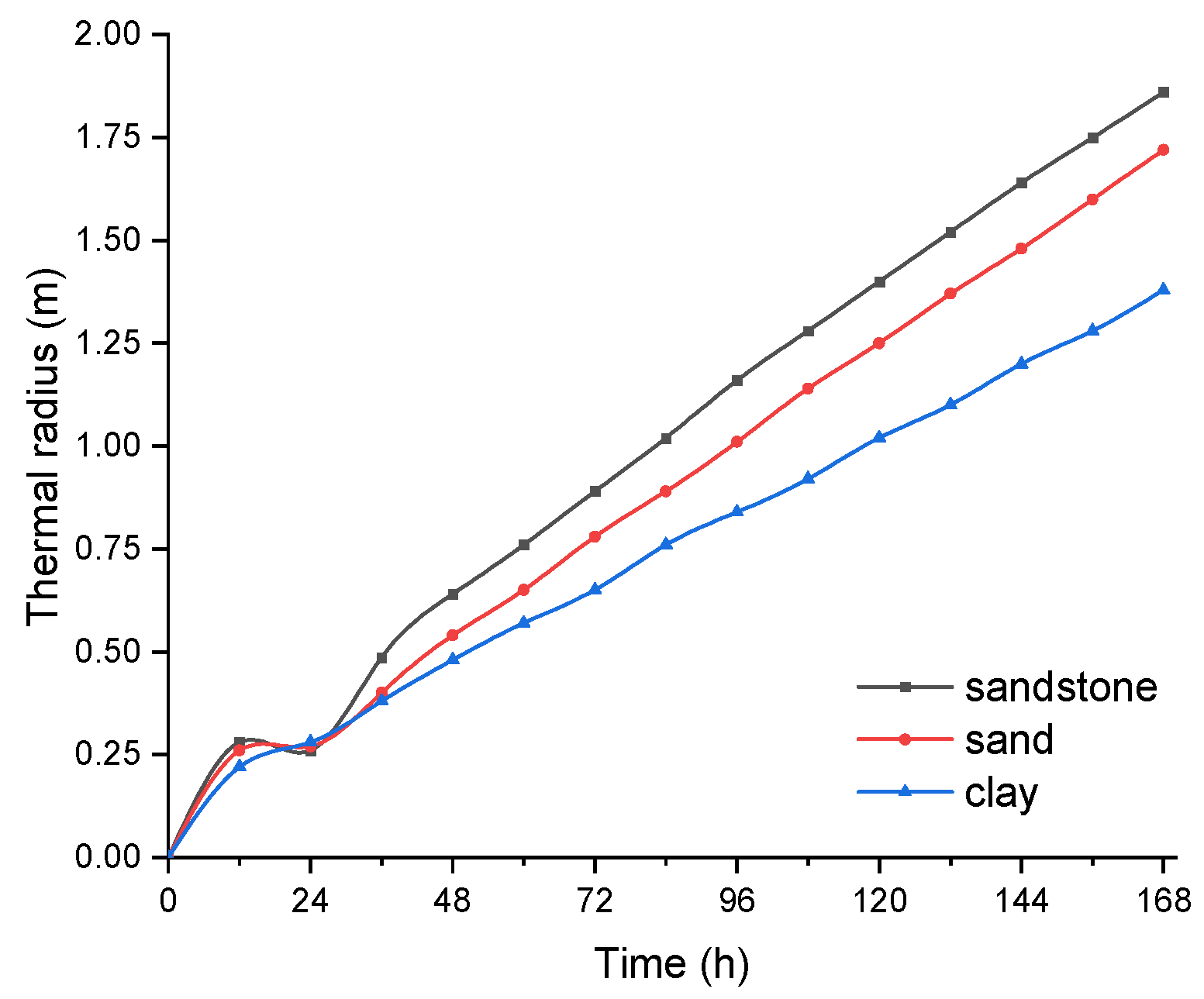
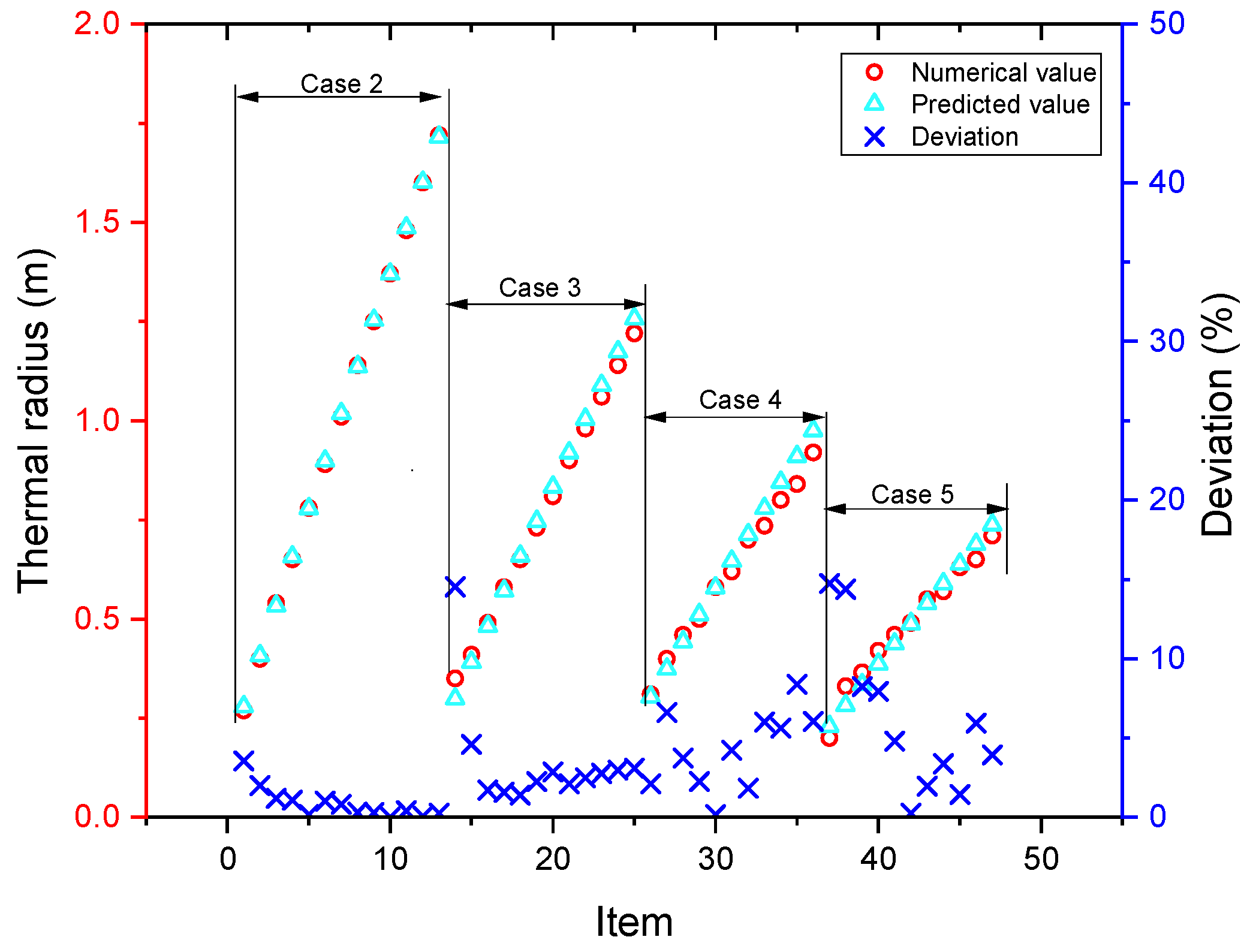
| Parameters | Value |
|---|---|
| Boreholes depth (m) | 82 |
| Pipe outer diameter (m) | 0.032 |
| Pipe wall thickness (m) | 0.003 |
| Legs center distance (m) | 0.07 |
| Borehole diameter (m) | 0.15 |
| Inlet velocity (m/s) | 0.7 |
| Inlet temperature for cool charged (°C) | 7 |
| Inlet temperature for cool discharged (°C) | 35 |
| Initial soil temperature (°C) | 18.4 |
| Item | Density/ | Thermal Conductivity/ | Specific Heat Capacity/ |
|---|---|---|---|
| soil (sand) | 1790 | 2.1 | 1465 |
| Backfill material | 2266 | 2.3 | 1731 |
| HDPE | 1100 | 0.46 | 1450 |
| water | 998.2 | 0.6 | 4182 |
| Terms | Conditions |
|---|---|
| Inlet of U-tube | Tinlet = 7/35 °C; vinlet = 0.7 m/s |
| Outlet of U-tube | Pressure outlet |
| Top and bottom boundaries of backfilling | No-slip wall with heat flux = 0 W/m2 |
| Soil zone Faraway boundary | No-slip wall with Dirichlet condition (T = 18.4 °C) |
| Type | Density | Specific Heat Capacity | Thermal Conductivity | Thermal Diffusivity |
|---|---|---|---|---|
| Clay | 1430 | 1439 | 0.862 | 0.42 |
| Sand | 1790 | 1465 | 2.1 | 0.8 |
| Sandstone | 2592 | 1065 | 2.98 | 1.08 |
| Coefficients | p-Value | Significance F | R Square | |
|---|---|---|---|---|
| −3.067613 | 0.0015009 | 4.2053 × 10−42 | 0.9449479 | |
| −0.366463 | 6.322 × 10−30 | |||
| 0.9323077 | 1.591 × 10−39 | |||
| 0.301736 | 5.492 × 10−7 |
Publisher’s Note: MDPI stays neutral with regard to jurisdictional claims in published maps and institutional affiliations. |
© 2021 by the authors. Licensee MDPI, Basel, Switzerland. This article is an open access article distributed under the terms and conditions of the Creative Commons Attribution (CC BY) license (https://creativecommons.org/licenses/by/4.0/).
Share and Cite
Zhu, S.; Sun, J.; Zhong, K.; Chen, H. Numerical Investigation of the Influence of Precooling on the Thermal Performance of a Borehole Heat Exchanger. Energies 2022, 15, 151. https://doi.org/10.3390/en15010151
Zhu S, Sun J, Zhong K, Chen H. Numerical Investigation of the Influence of Precooling on the Thermal Performance of a Borehole Heat Exchanger. Energies. 2022; 15(1):151. https://doi.org/10.3390/en15010151
Chicago/Turabian StyleZhu, Shuiping, Jianjun Sun, Kaiyang Zhong, and Haisheng Chen. 2022. "Numerical Investigation of the Influence of Precooling on the Thermal Performance of a Borehole Heat Exchanger" Energies 15, no. 1: 151. https://doi.org/10.3390/en15010151






